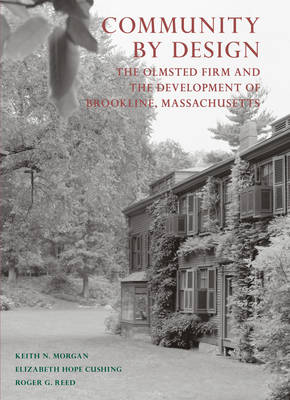
- Retrait gratuit dans votre magasin Club
- 7.000.000 titres dans notre catalogue
- Payer en toute sécurité
- Toujours un magasin près de chez vous
- Retrait gratuit dans votre magasin Club
- 7.000.0000 titres dans notre catalogue
- Payer en toute sécurité
- Toujours un magasin près de chez vous
Community by Design
The Olmsted Firm and the Development of Brookline, Massachusetts
Keith N Morgan, Elizabeth Hope Cushing, Roger G ReedDescription
In 1883, Frederick Law Olmsted moved from New York City to Brookline, Massachusetts, a Boston suburb that anointed itself the "richest town in the world." For the next half century, until his son Frederick Law Olmsted Jr. relocated to California in 1936, the Olmsted firm received more than 150 local commissions, serving as the dominant force in the planned development of this community. From Fairsted, the Olmsteds' Brookline home and office, the firm collaborated with an impressive galaxy of suburban neighbors who were among the regional and national leaders in the fields of architecture and horticulture, among them Henry Hobson Richardson and Charles Sprague Sargent.
Through plans for boulevards and parkways, residential subdivisions, institutional commissions, and private gardens, the Olmsted firm carefully guided the development of the town, as they designed cities and suburbs across America. Frederick Law Olmsted Sr. and Jr. and their associates represented a new cohort of professionals who worked well in tandem with the wealthy, ensuring both the visual quality and the social hierarchy of the community.
While Olmsted Sr. used landscape architecture as his vehicle for development, his son and namesake saw Brookline as grounds for experiment in the new profession of city and regional planning, a field that he was helping to define and lead. Little has been published on the importance of Brookline as a laboratory and model for the Olmsted firm's work. This richly illustrated book provides important new perspective on the history of planning in the United States and illuminates an aspect of the Olmsted office that has not been well understood.
"Chock full of details (with hundreds of reproduced photos and plans) and meticulously researched, the book exposes the multiple webs of influence; wealth, social hierarchy, design genius and high-minded ideals that came together to guide the development of Brookline at a time when booming population and streetcars brought rapid change. The authors trace the relationships among the leading trend-setters in architecture, municipal governance, landscape design, engineering and horticulture as they converge in Brookline at the turn of the 19th century." --Brookline Perspective
Spécifications
Parties prenantes
- Auteur(s) :
- Editeur:
Contenu
- Nombre de pages :
- 320
- Langue:
- Anglais
Caractéristiques
- EAN:
- 9781952620225
- Date de parution :
- 01-01-13
- Format:
- Livre relié
- Format numérique:
- Genaaid
- Dimensions :
- 152 mm x 229 mm
- Poids :
- 453 g

Les avis
Nous publions uniquement les avis qui respectent les conditions requises. Consultez nos conditions pour les avis.






